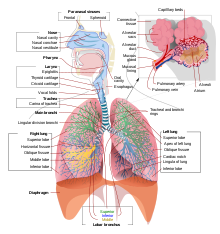
Back فشل تنفسي Arabic Insuficiencia respiratoria AST Respiratorna insuficijencija BS Insuficiència respiratòria Catalan Respiratorische Insuffizienz German Insuficiencia respiratoria Spanish Hingamispuudulikkus ET Arnas gutxiegitasun EU نارسایی تنفسی FA Hengitysvajaus Finnish
| Respiratory failure | |
|---|---|
 | |
| Respiratory system | |
| Specialty | Pulmonology, Intensive care medicine |
Respiratory failure results from inadequate gas exchange by the respiratory system, meaning that the arterial oxygen, carbon dioxide, or both cannot be kept at normal levels. A drop in the oxygen carried in the blood is known as hypoxemia; a rise in arterial carbon dioxide levels is called hypercapnia. Respiratory failure is classified as either Type 1 or Type 2, based on whether there is a high carbon dioxide level, and can be acute or chronic. In clinical trials, the definition of respiratory failure usually includes increased respiratory rate, abnormal blood gases (hypoxemia, hypercapnia, or both), and evidence of increased work of breathing. Respiratory failure causes an altered mental status due to ischemia in the brain.
The typical partial pressure reference values are oxygen Pa O
2 more than 80 mmHg (11 kPa) and carbon dioxide Pa CO2 less than 45 mmHg (6.0 kPa).[1]